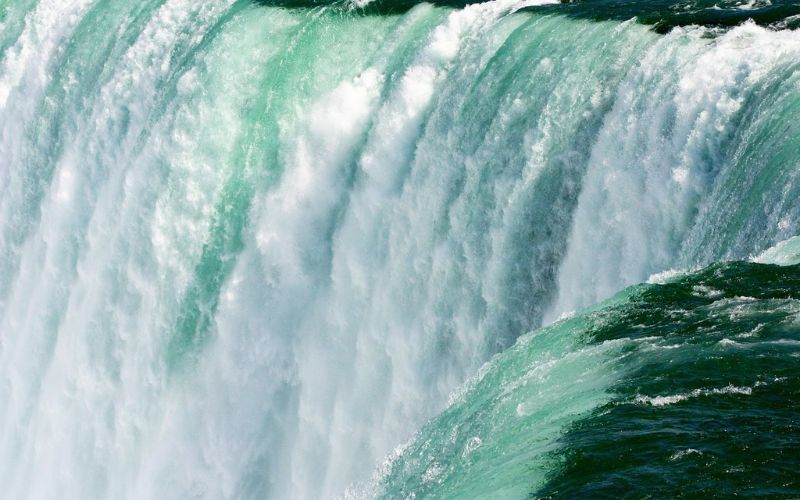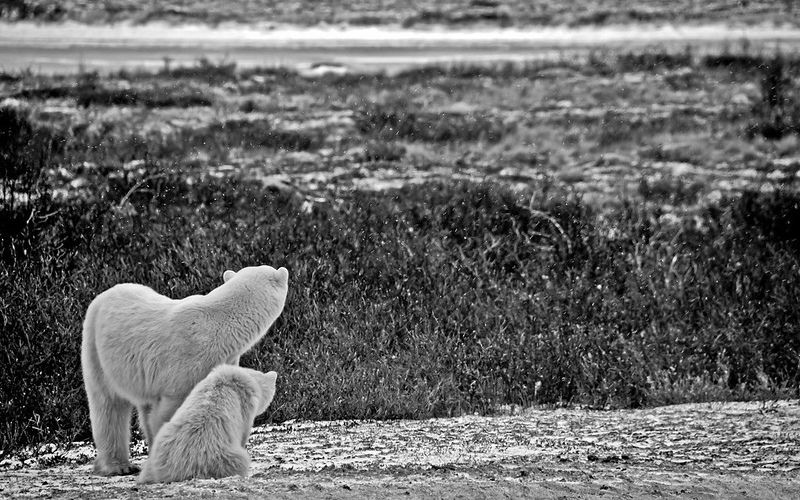Niagara Falls may be the most frequented tourist destination in Canada (the jury is still out on which side has the better view), but if you really want to explore the country in detail, you’ll be amazed by the range of diversity it offers. Canada is touted as a great example of multiculturalism and its influence is visible in the cuisine, lifestyle, and overall vibe of the country. The country offers a plethora of tourist activities all throughout the year. If you are visiting planning a Canada winter vacation, checkout this interesting fact about Canada, guide on tourist attractions and things to do.
What to Do in Canada During Cold Winters?
1. Niagara Falls

Well, the place that attracts over 30 million tourists is one of the best places to visit in Canada in winter. The iconic natural wonder Niagara Falls attracts tourists from all over the world, but the spectacle is mesmerizing and breathtaking in the winters. There are a number of shops and eateries near the Niagara Falls which offer quality food and snacks. You can take a little bit of Niagara Falls with you by buying souvenirs from the venue. Considering the high cost of living in Canada, it’s better if you keep your Niagara Falls visit to a day affair.
2. Lunenburg

A picturesque downtown with a strong archaic architecture and port, Lunenburg in Nova Scotia is a tourist attraction that’s preserved its traditional culture while adapting to the grinds of the urbane living. While visiting Lunenburg, you can’t help but notice a strong sense of community among the fishermen community whose ancestors have called the place home for over three centuries. festWhile Lunenburg can be visited all year long, during the month of July, the laidback town comes truly alive with its array of Canada festivals and events, including Nova Scotia Folk Art Festival and Lunenburg Street Festival.
3. Eastern Townships

What to see in Canada during winters? Simple, Eastern Townships – the place has a history to it and it is quite palpable when one visits the place. A large number of people in Canada speak French, and if you want to experience that distinctive flavor of language, food, culture, and other idiosyncrasies in North America, Eastern Townships in Quebec are the best place to go to.
Eastern Townships are a tourist attraction all throughout the year, and visiting the vineyards and organic farms is a favorite tourist activity in this part of the country. The adventurous kind can have a shot at adventurous activities like skiing and snowmobiling. Summers and winters are packed with tourists; if you are looking for a bit of a silent retreat, fall may be the time for you.
4. The Discovery Islands

You may not have heard of the Discovery Islands from friends or relatives who have visited Canada before – the reason being these beautiful islands can only be reached through a kayak. However, these hidden gems are too magnificent to be ignored. While winters may not be the best time to visit the Discovery Islands owing to the chill, you can have a beautiful experience during the summers. While getting to the place may be a bit tedious, commute options are abound. You can rent a bike and explore the beautiful surroundings at your own pace.
5. Churchill

If you don’t already know this, Churchill in Manitoba is the polar bear capital of the world. Although you may have to wait till August next year to meet the famous visitors, as they migrate by the end of November. Churchill is also the place to meet beluga whales who arrive here during the summers. However, considering the popularity of this place, especially during the winters, it’s recommended that you make reservations with tour operators.
Other places that are frequented by tourists include,
- Agawa Canyon
- Cape Breton
- Prince Edward Island
- Yellowknife and Great Slave Lake
While visiting tourist attractions is a great way of making the most of your Canada trip, it’s also important to think of your stomach! Big Canadian cities, including Toronto, Vancouver, Ottawa, Calgary, Ottawa, Edmonton, etc. have a number of restaurants that are renowned globally for their offerings. If you are wondering what to eat in Canada, consider these top 10 restaurants in Canada for a delicious food outing.
- Buca Yorkville
- Initiale
- Joe Beef
- DandyLion
- Bar Isabel
- Nota Bene
- Boulud
- DaiLo
- Model Milk
- Mallard Cottage
Why visit Canada in Winter?
Winter in Canada is itself a surreal site to witness. As the country embraces the chills from November, it transforms into a winter wonderland lasting at least till the end of March and early April. But, isn’t Canada too cold to explore during winter? Well yes, but unlike warmer months you will get to discover some of the rarest experiences in your lifetime. Various factors influence travellers across the world to visit Canada in winter some of them include:
- Outdoor activities: Canada is home to some of the best ski resorts in the world and offers the top winter activities to enjoy. Beyond skiing, you can consider snowmobiling, snowshoeing, snow tubing, cross-country skiing, ice, fishing, and skating.
- Winter Festivals and Events: Though it’s the lowest season for tourism, Canada never fails to make the most of every season. As the winter falls, the country is full of festivals and events to make it fun and memorable. These festivals are quite unique and always tend to highlight some of the unusual aspects of the season.
- Winter’s beauty: Winter is simply magical! The beautiful white power covering trees and mountains, frozen lakes, cosy homes, and winter delicacies make it worth exploring Canada.
- Cheaper accommodation and travel expenses: without a doubt, travelling to Canada in winter is cheaper than in summer. Since the demand is lower, the accommodation and travel charges drop and become extremely budget-friendly. And if this is your first time, you can simply look for a guide to a winter vacation in Canada making it a smooth and easy trip.
Other factors include wildlife watching, the northern lights, and fewer crowds.
The Best Things to do in Canada in Winter
In addition to exploring the above attractions, there are other experiences to be had across Canada. Some of them include:
- Experiencing fat bike rides through snow-covered forests.
- Stunned by the ultimate sight of the Northern lights.
- Ice fishing in one of the many authorised frozen lakes.
- Cross-country skiing while passing through the stunning landscapes.
- Snowshoeing through beautiful trails.
- Skating on the largest naturally frozen skating rink in the Rideau Canal.
- Discovering mystic wildlife in the national parks.
Travel Practicalities
The magical experience in Canada does not come without a few hurdles. However, it is essential for you to learn them before planning your trip.
Tourist attractions and services in Canada are usually for limited hours during Winter. Always check for operational updates as some completely shut down for the entire winter season.
Plan a flexible itinerary that allows your plan to change during delays. With keeping the weather changes in mind, your plans may not always go as planned. Make sure to purchase travel insurance before leaving.
Take your own time exploring Canada in winter as things usually move a bit slower and quitter here.
Winter Weather in Canada
Weather in Canada during winter are extremely cold and can dip to below 0 degrees. Expect the weather to be all over the regions from snow to rain to ice to sleet to complete white outs. The temperatures during daytime range between -5 to -15 Celsius (23 to 5 F) and during the night they can drop as low as -30 to -14 Celsius (-20 to -40 F).
What to wear?
This is one of the crucial things to consider when visiting Canada during winter. The key to dressing is to wear multiple layers. A warm jacket is a must for the top layer. If you are travelling in drier regions synthetic is preferred and if you are visiting BC’s West Coast carry a waterproof jacket.
Next is the mid-layer. It helps to provide insulation and is typically made of polyester fleece or wool. The core of the closest to the skin is the base layer. These are known as thermals and they keep your skin dry. The base layer is often made from polyester or wool.
With these, don’t forget to cover the extremities of the body with a beanie, gloves, and a good pair of socks. Now you are good to go!
Winter driving in Canada
Ice-covered roads are something you should not take lightly when driving. If you are someone with zero winter driving experience, you should strongly look for the risks and consequences in case of unfortunate situations.
Below are a few tips to keep in mind when driving in Canada
- Always go slow as the slippery roads, reduced visibility, black ice, and heavy snowfall make it risky for speed driving.
- Roadside services are limited during winter, so be prepared with all the facilities you will need when driving.
- Carry necessary equipment including winter tires, jumper cables, a shovel, and tow rope. Always check the windscreen washer fluid levels and maintain good visibility when driving.
We hope the information presented in this article helps you plan ahead so that you and your loved ones have a fabulous time in Canada. Always keep your research updated and for more information get your guide to winter in Canada. If you know of any special things to do or any hidden gems to visit, do let our readers know about it.